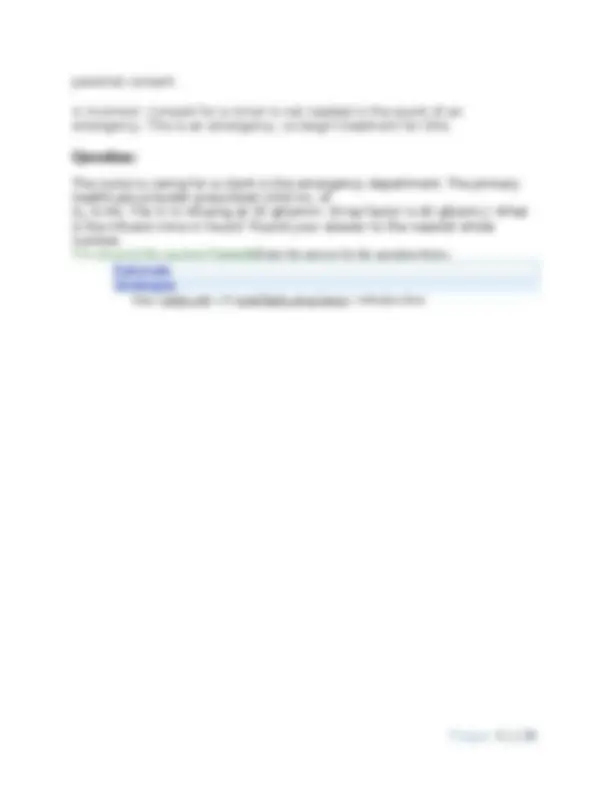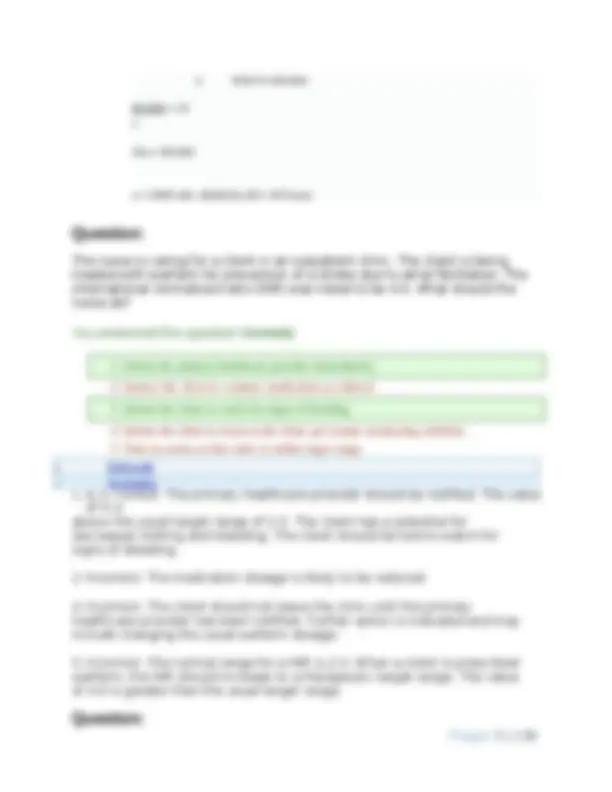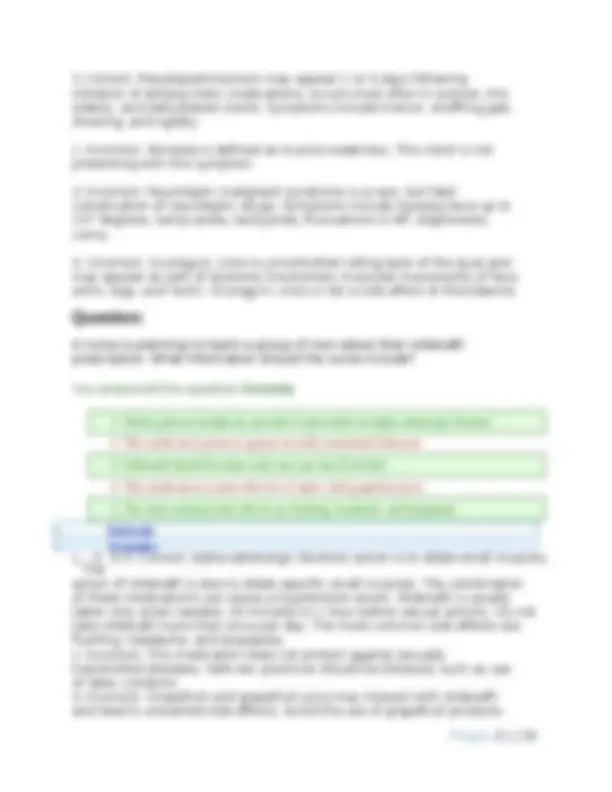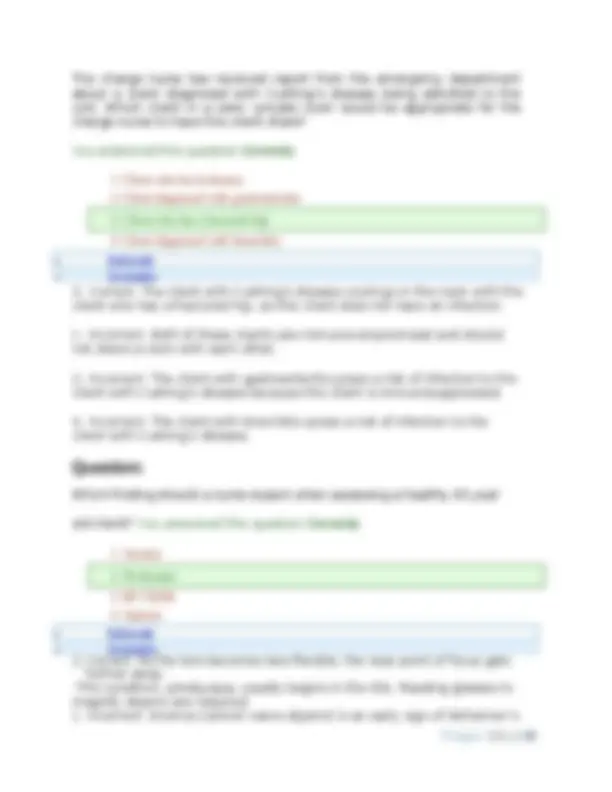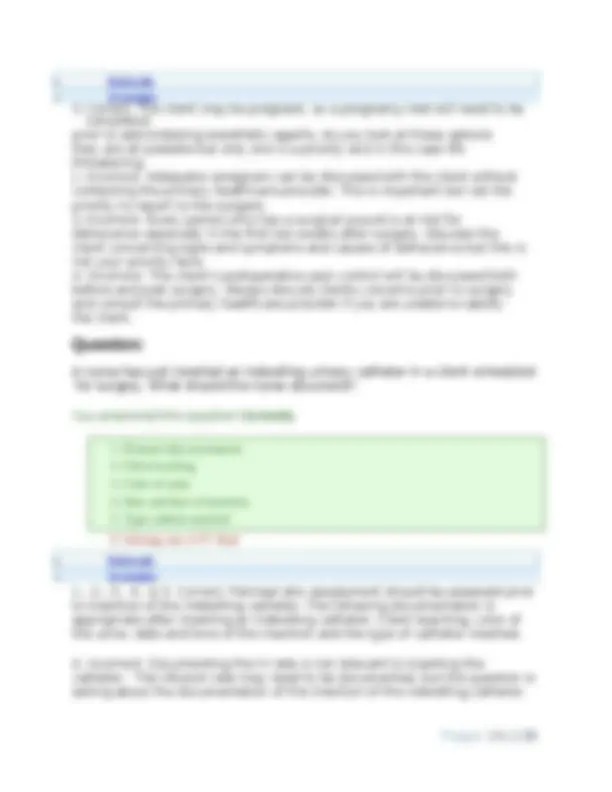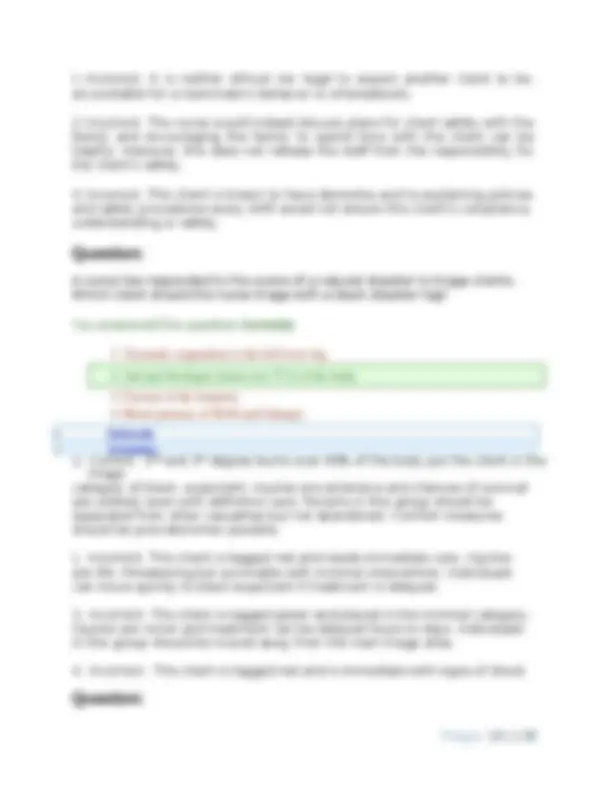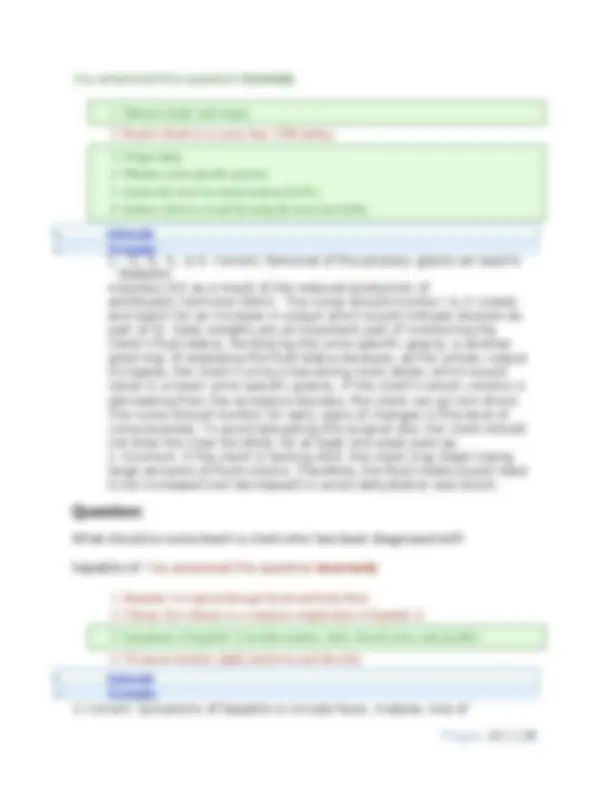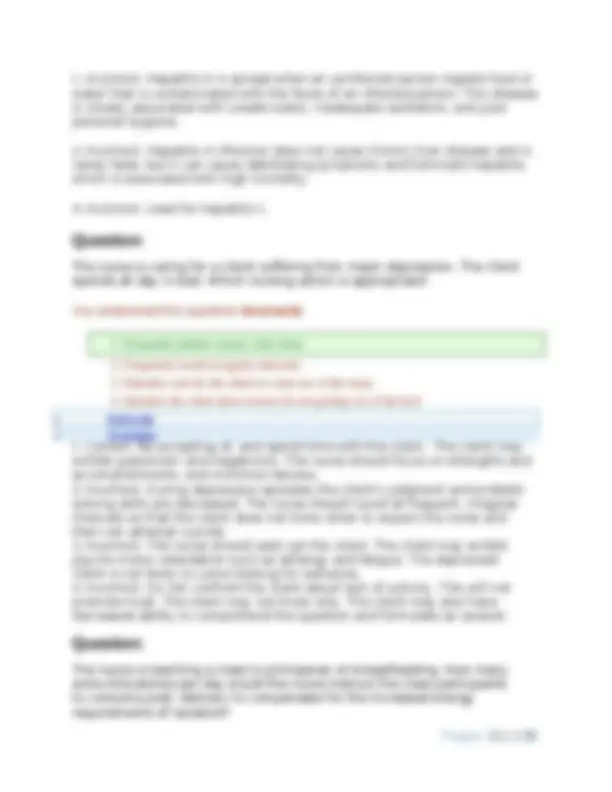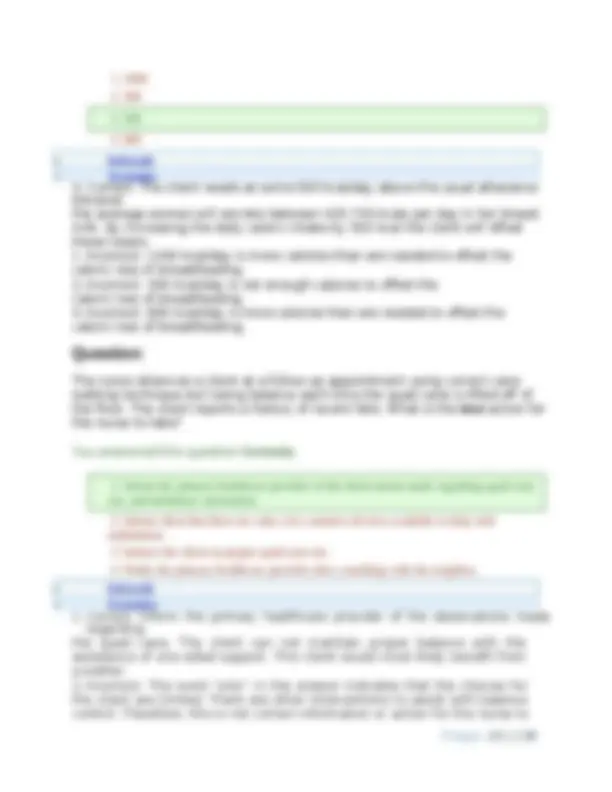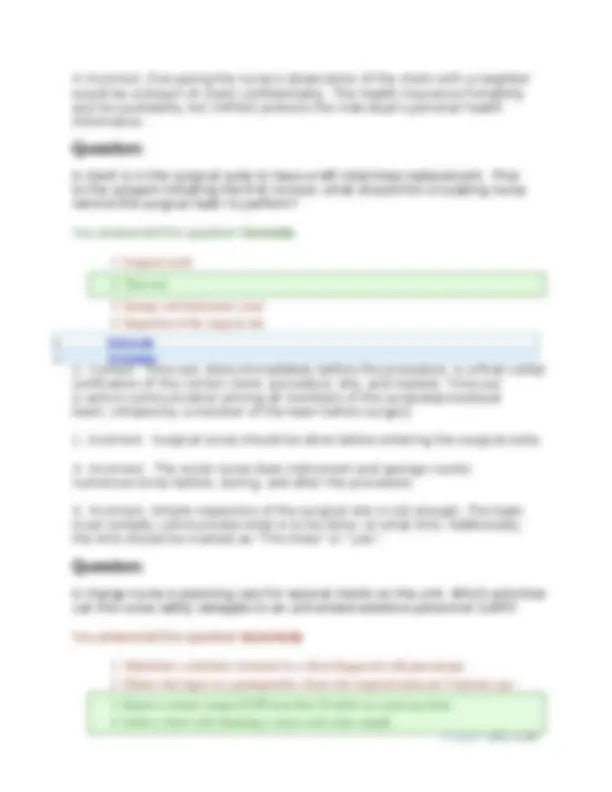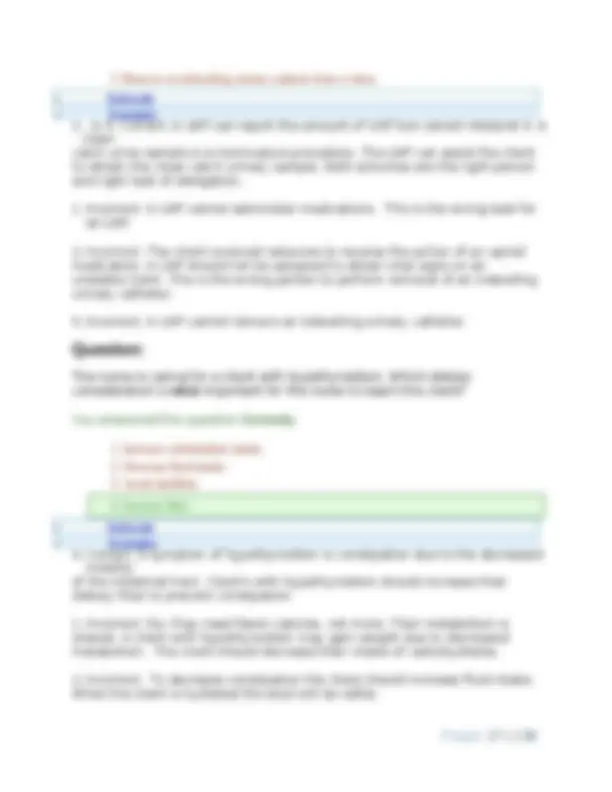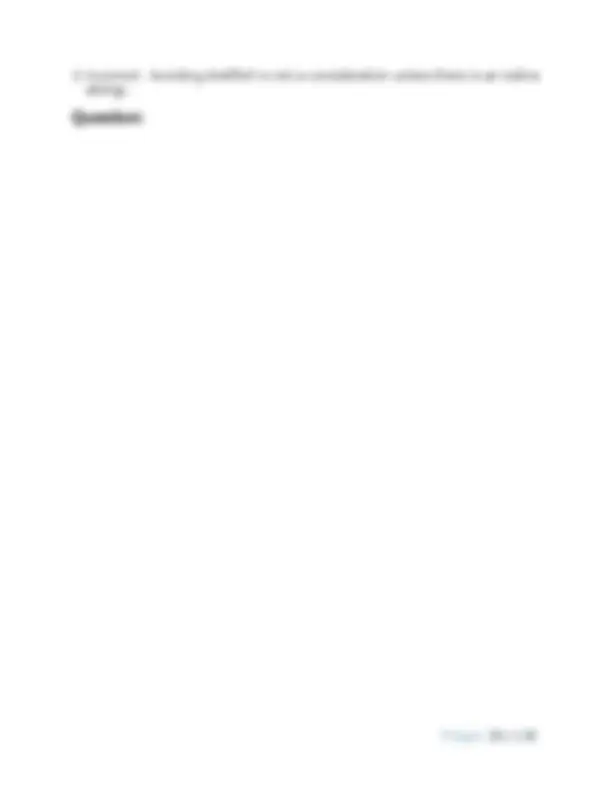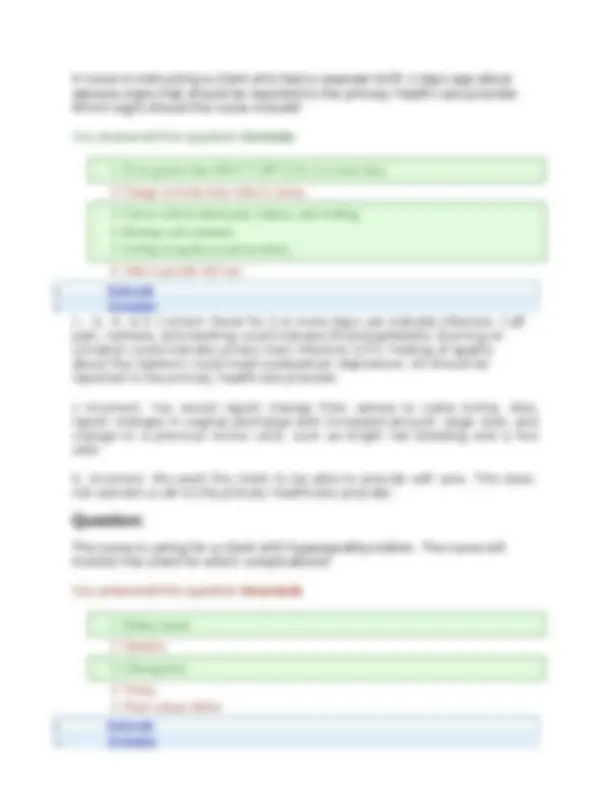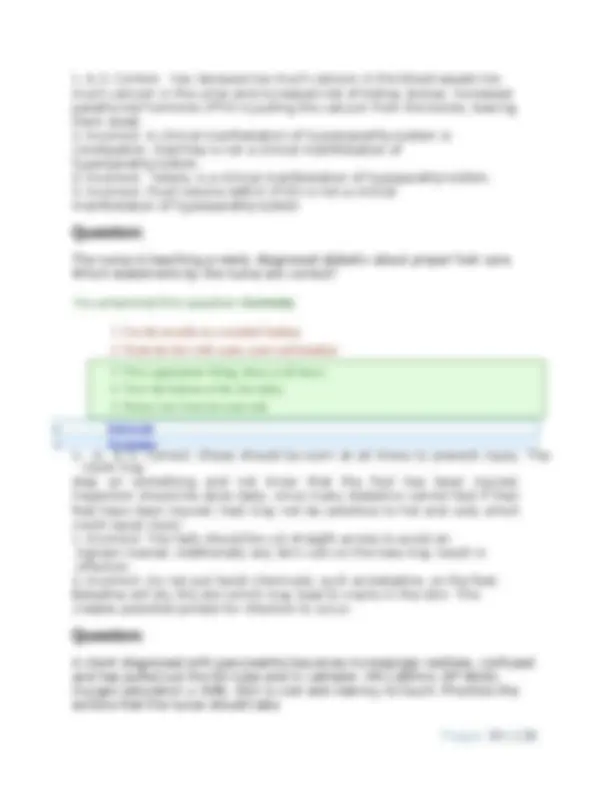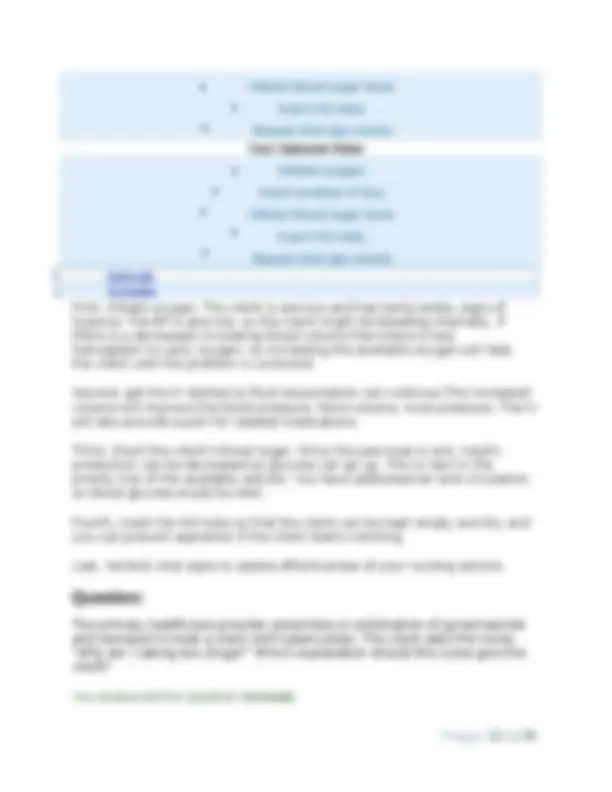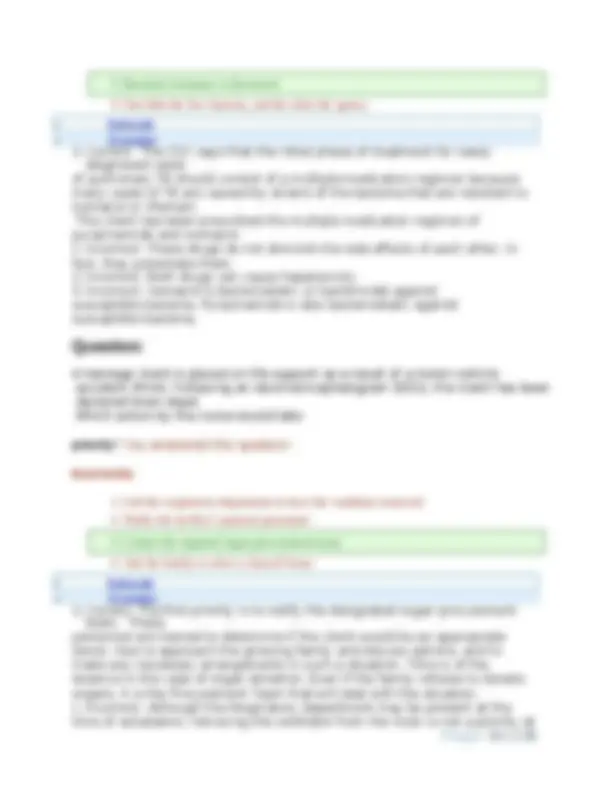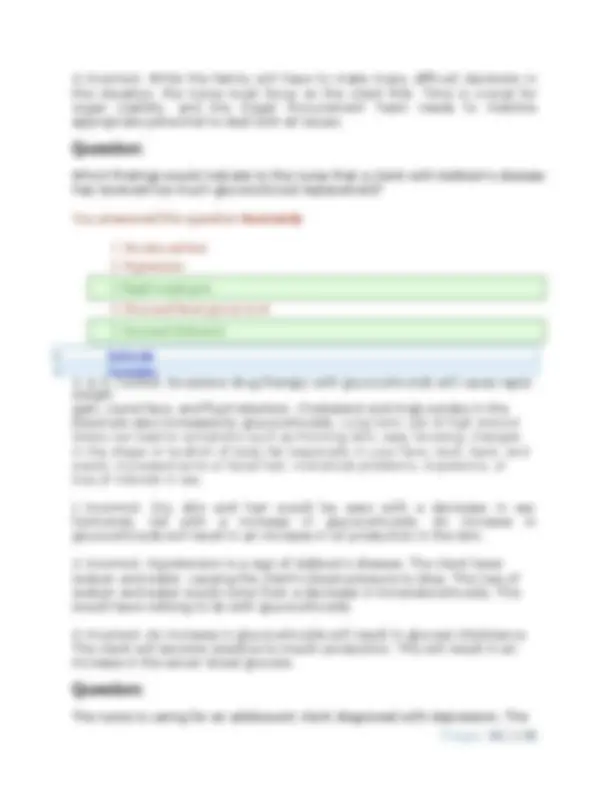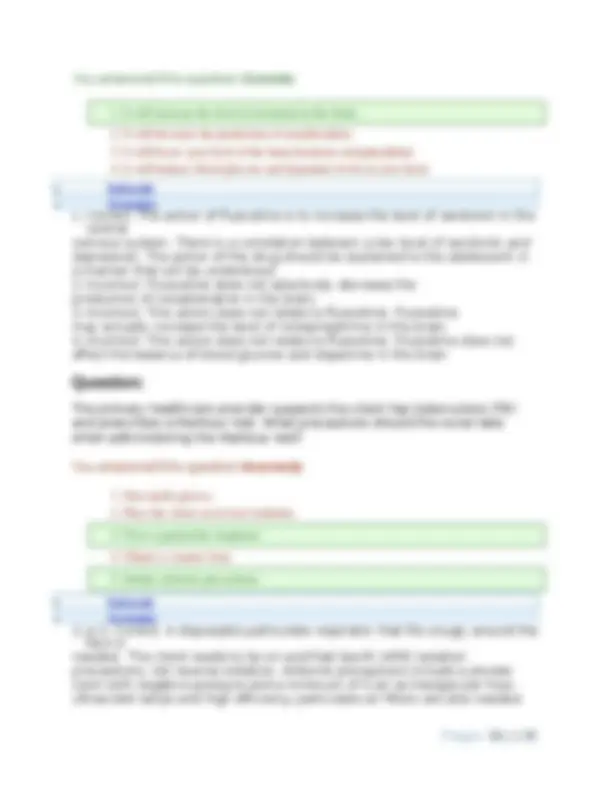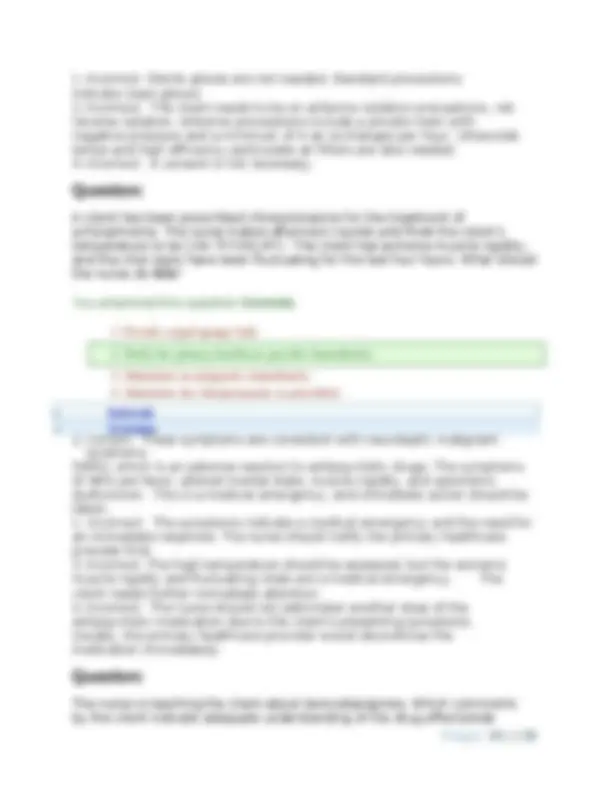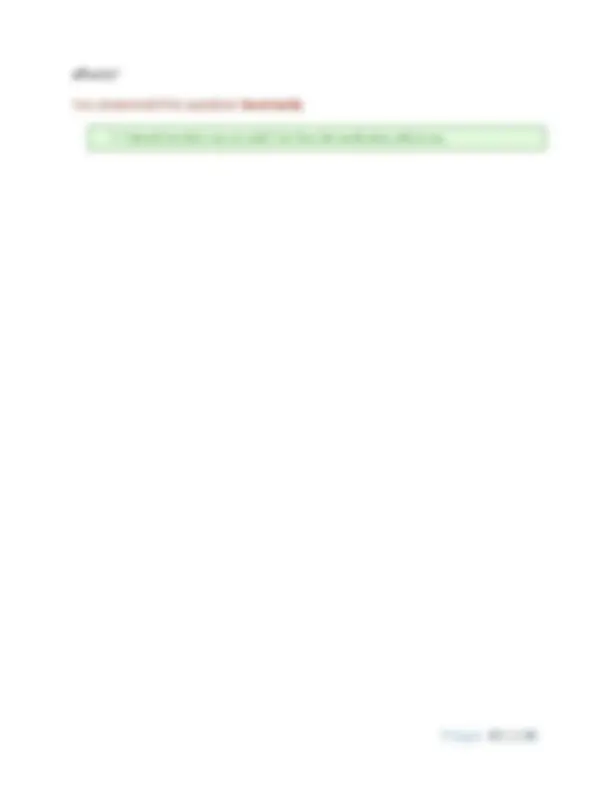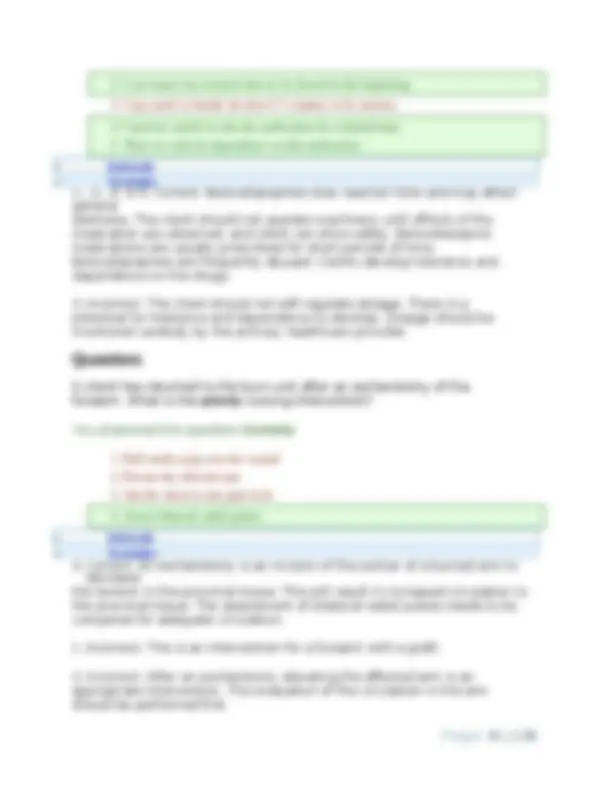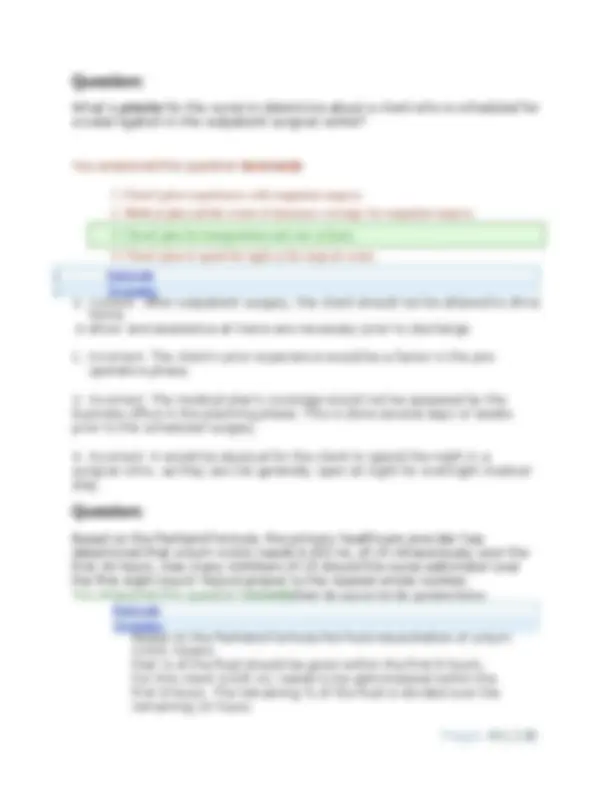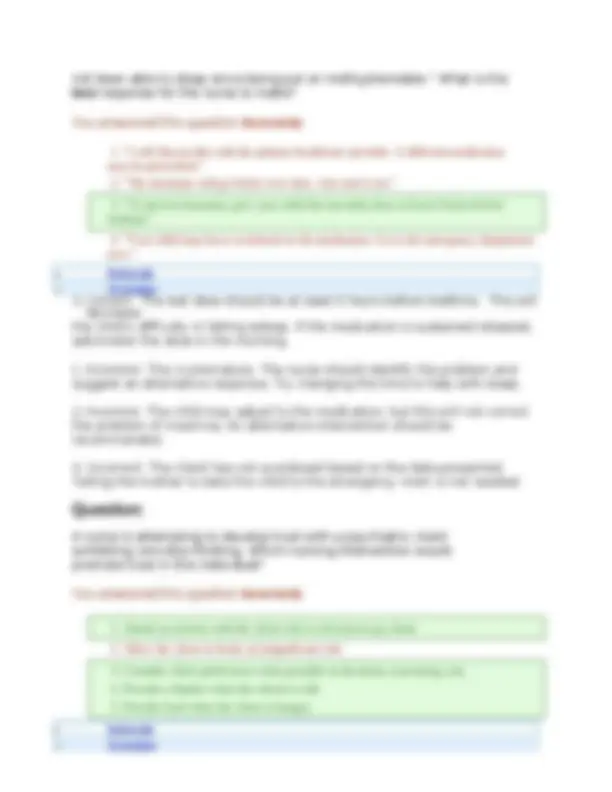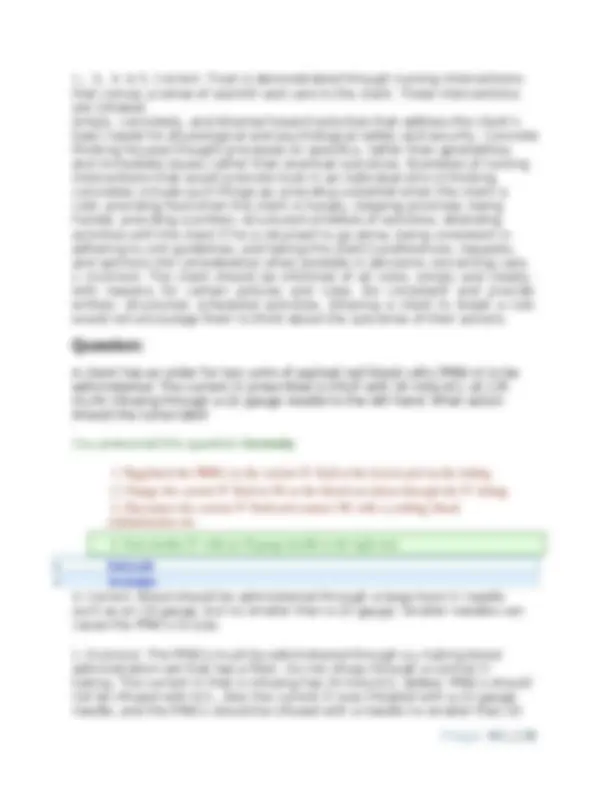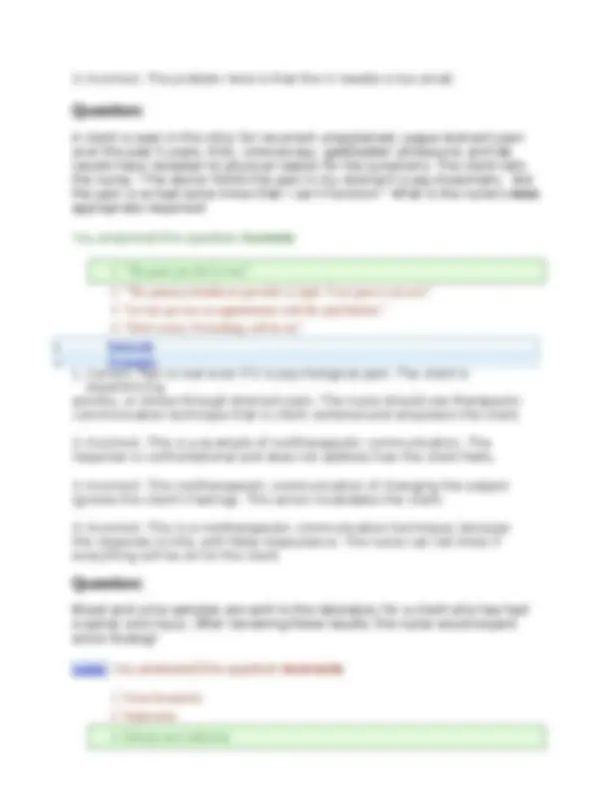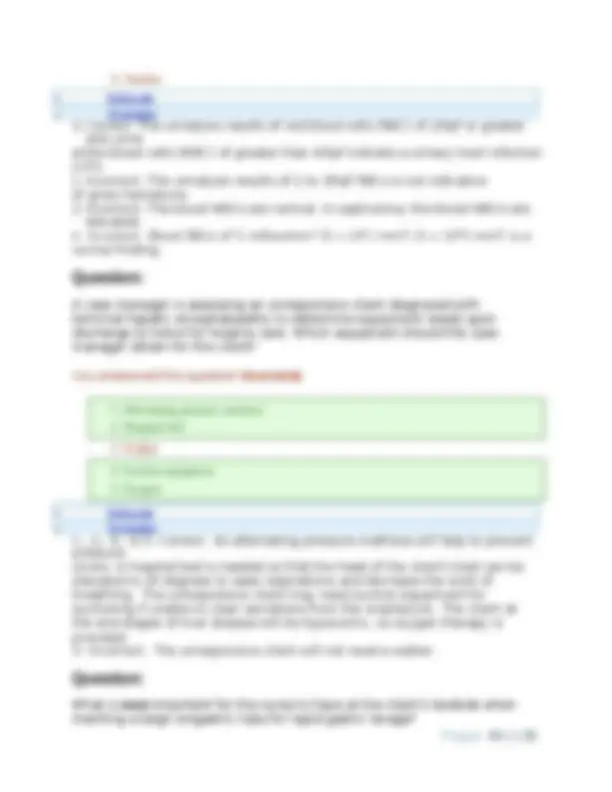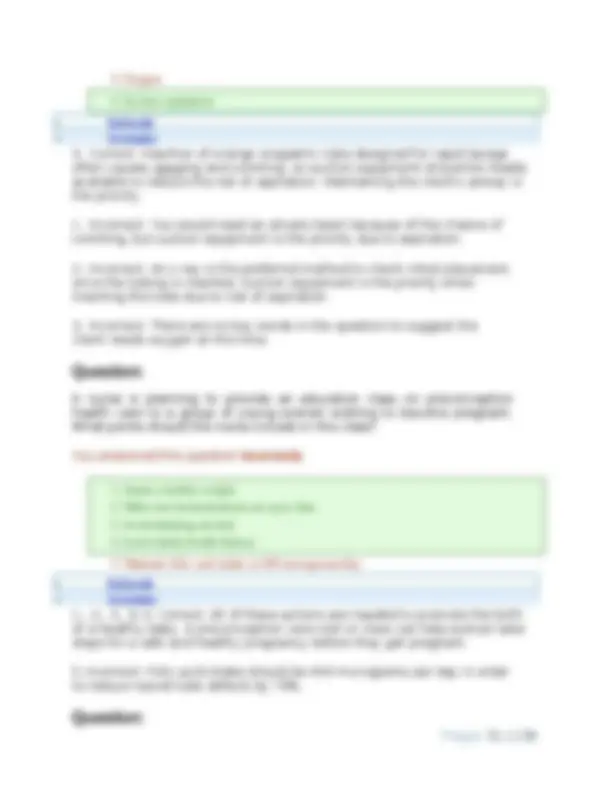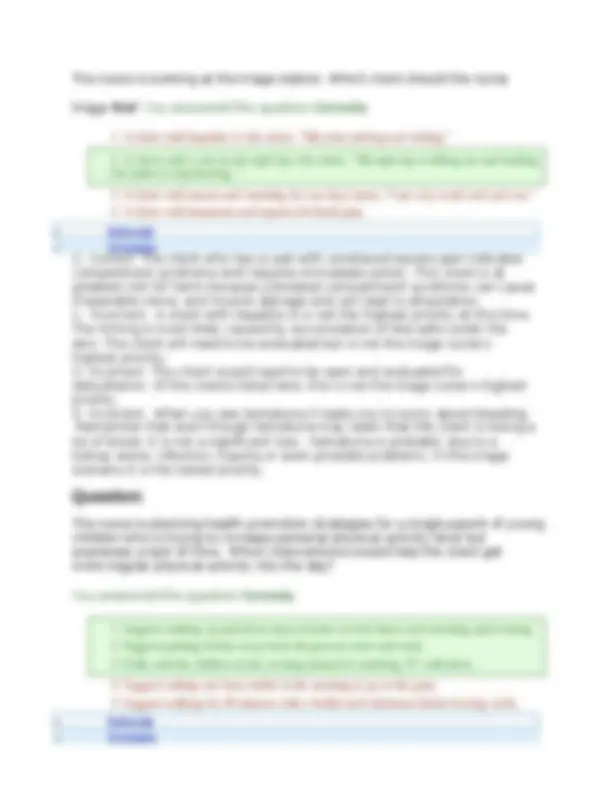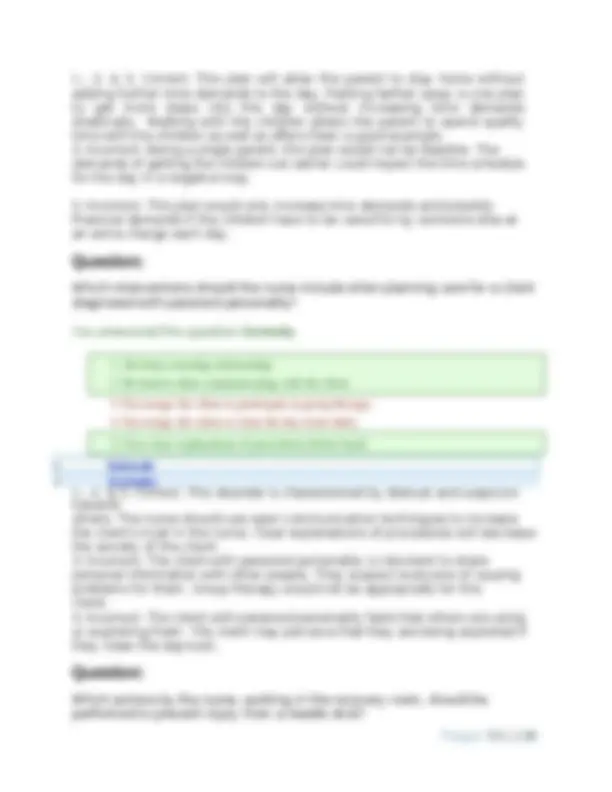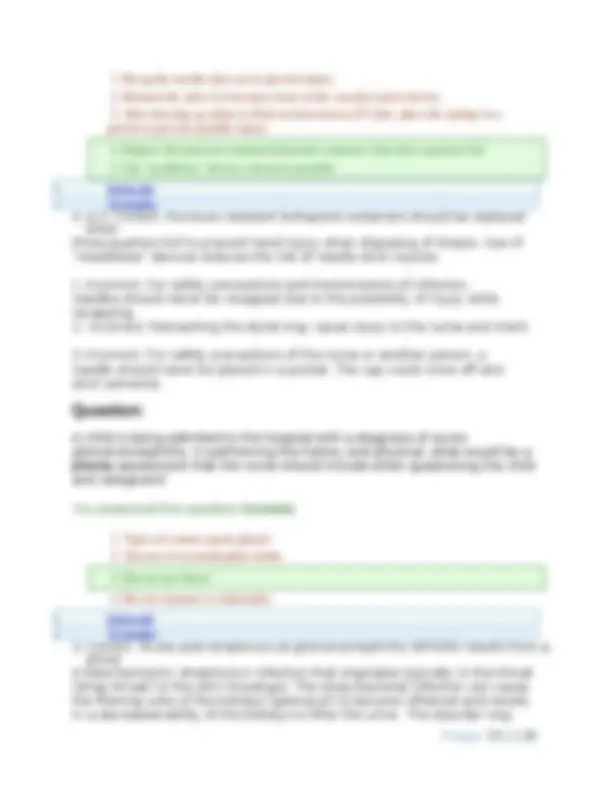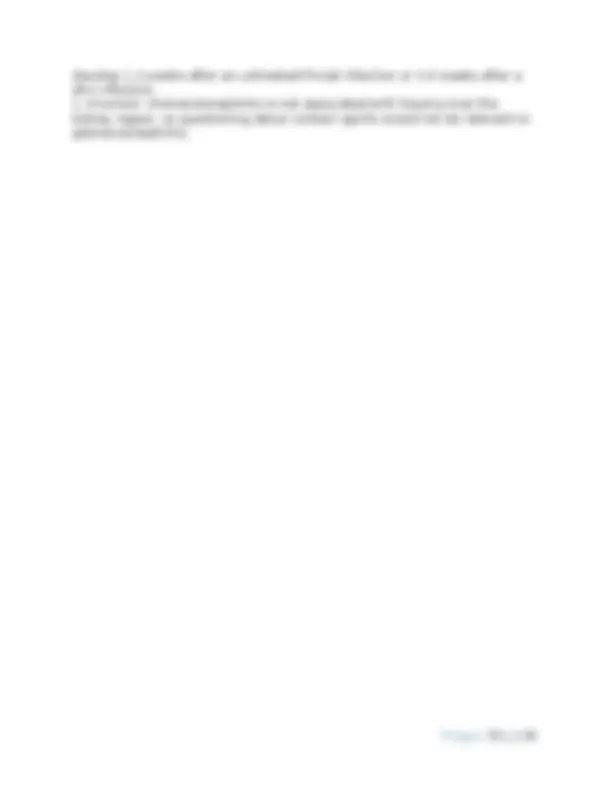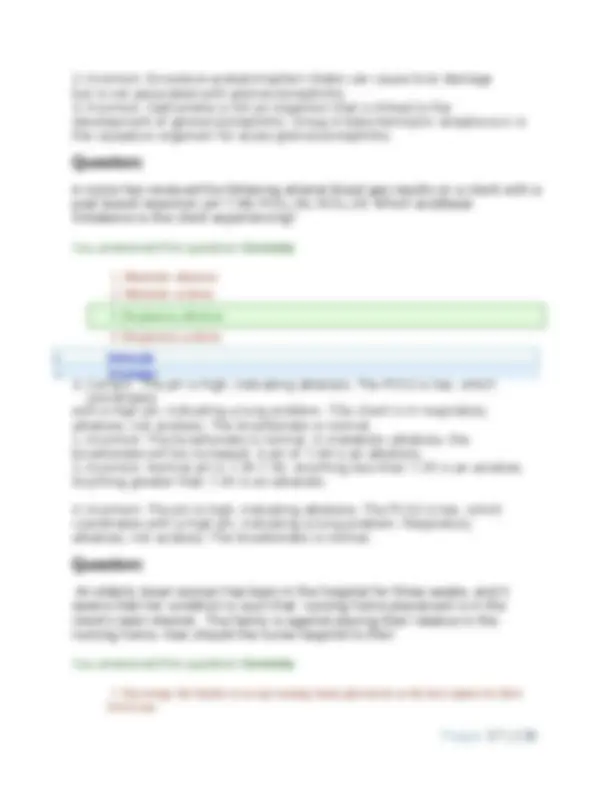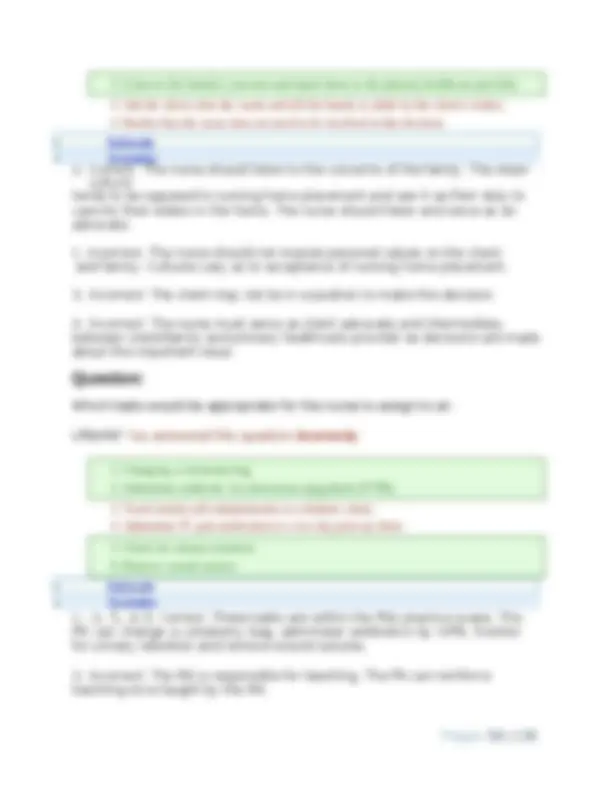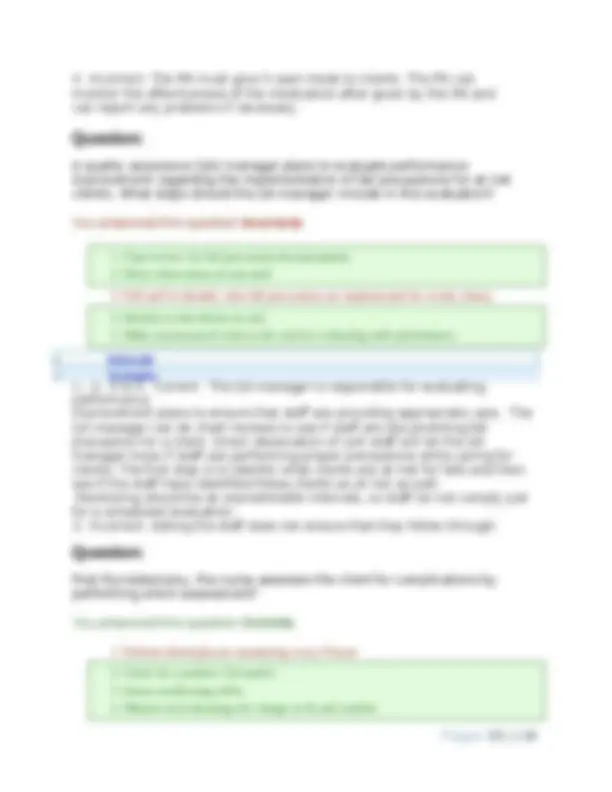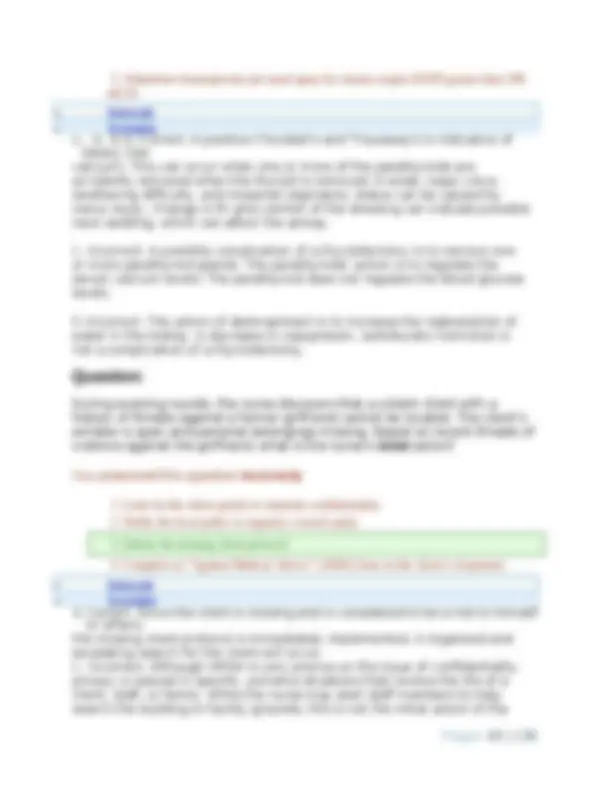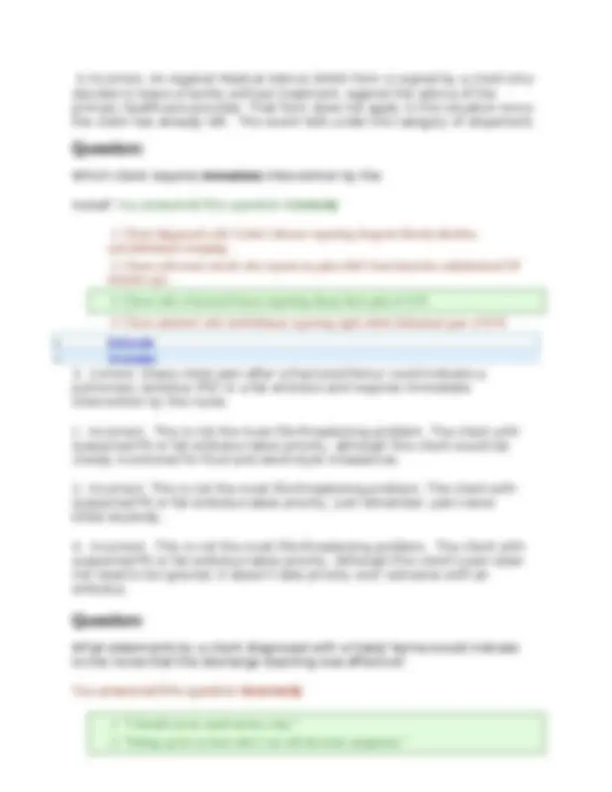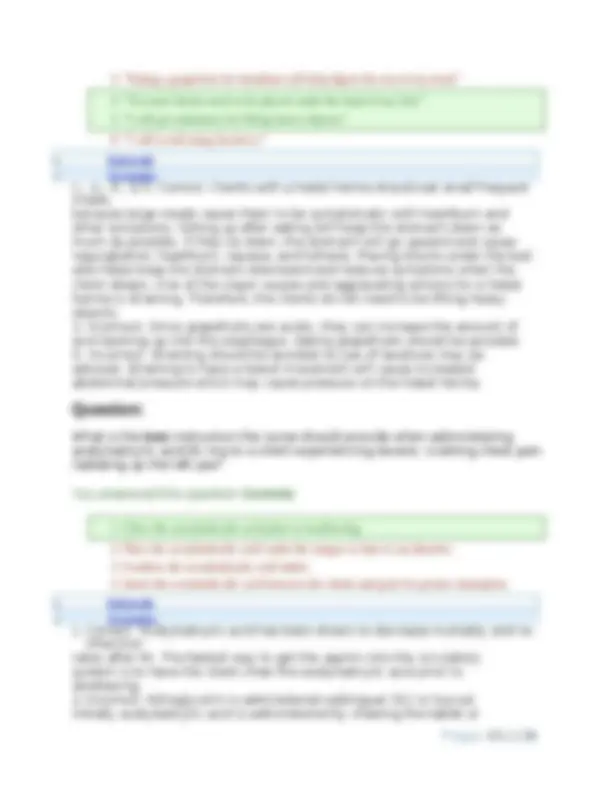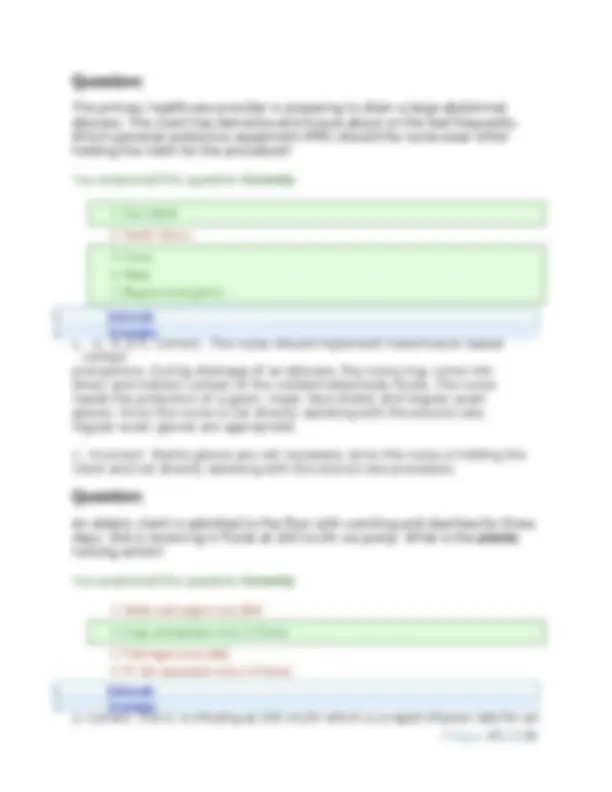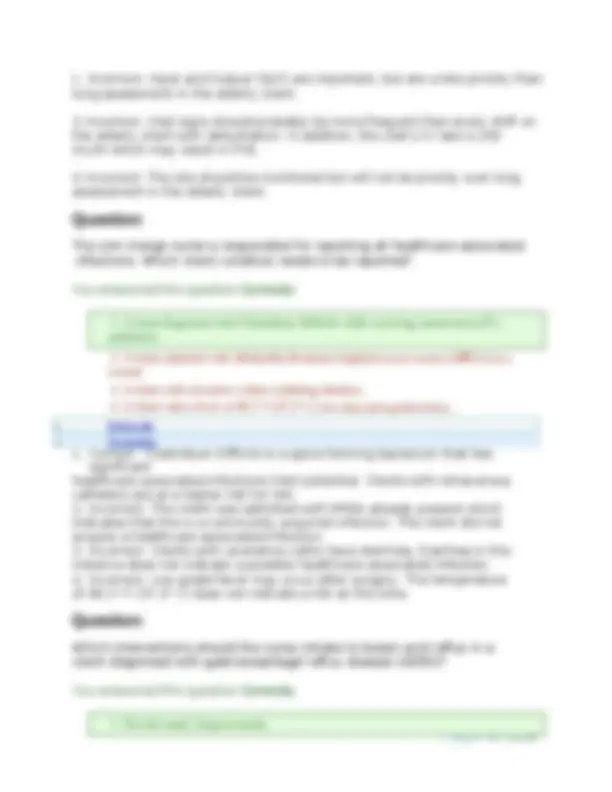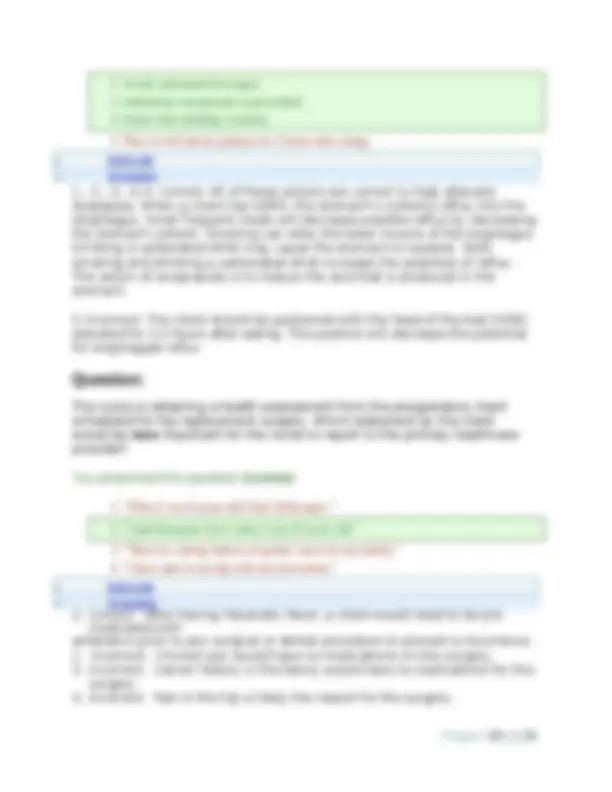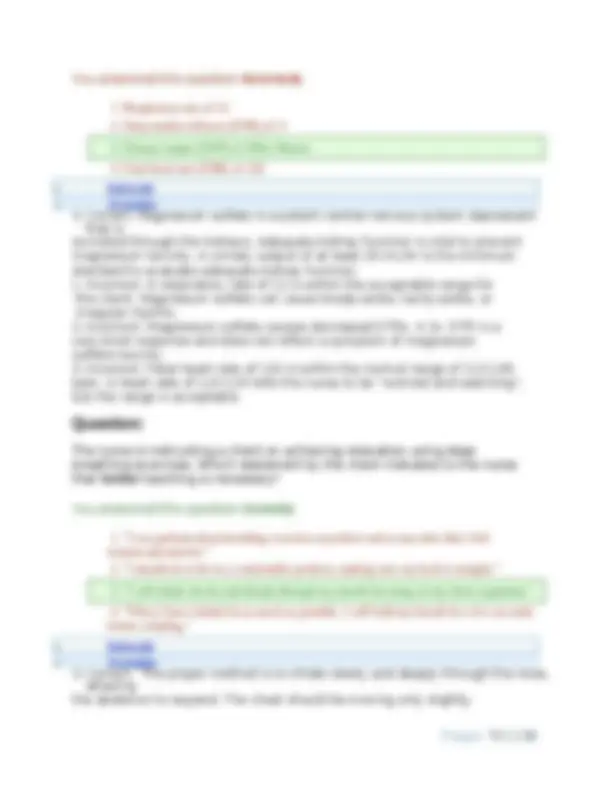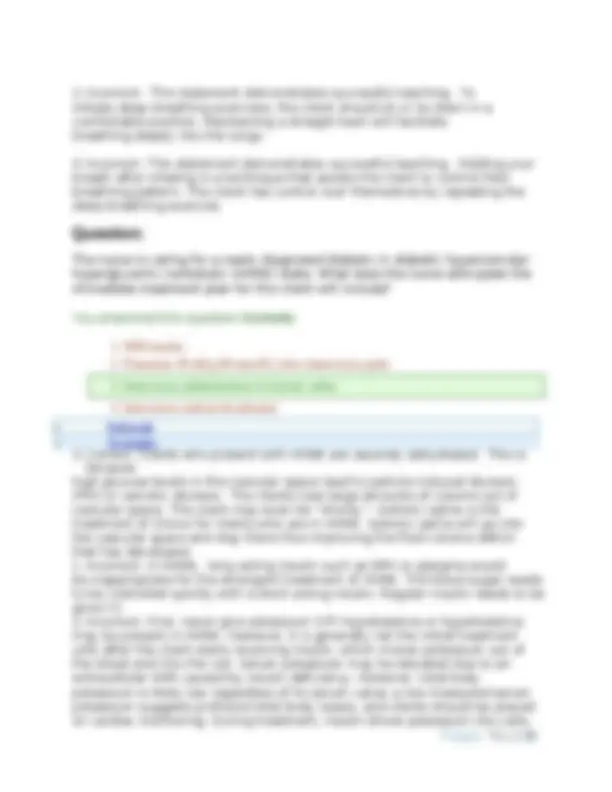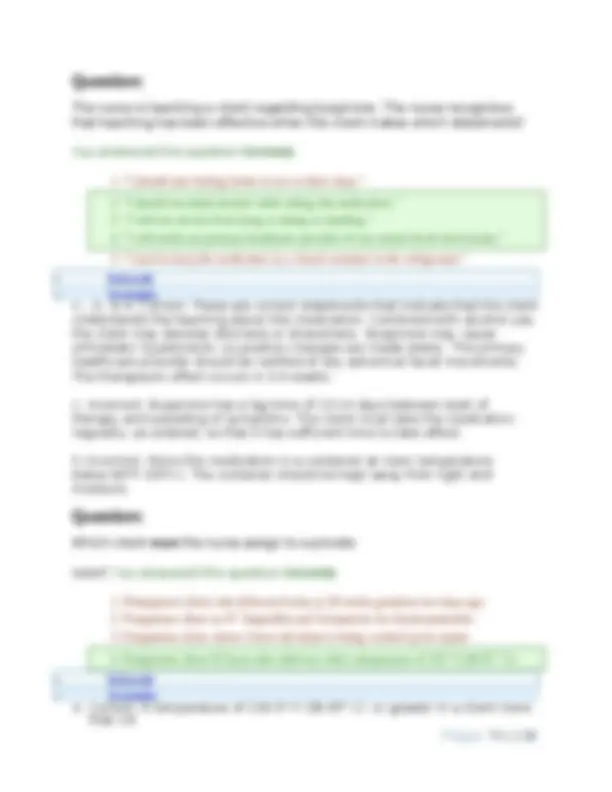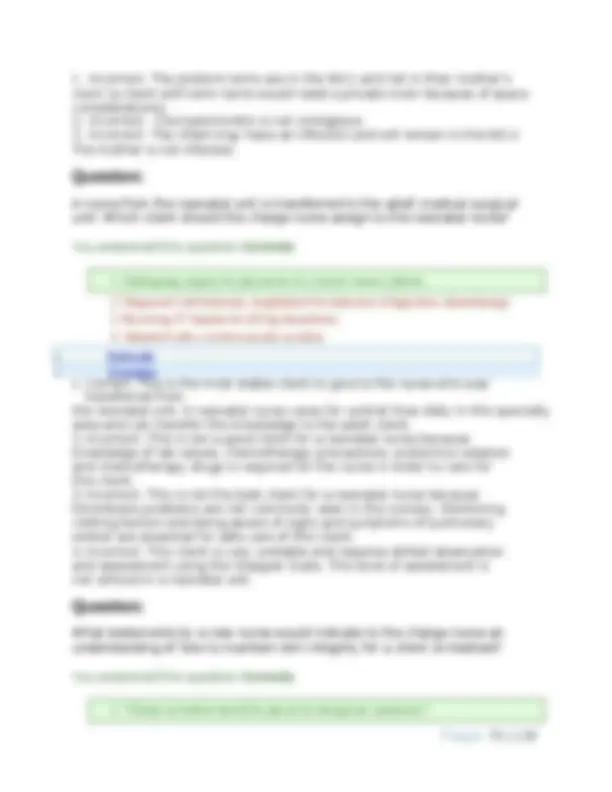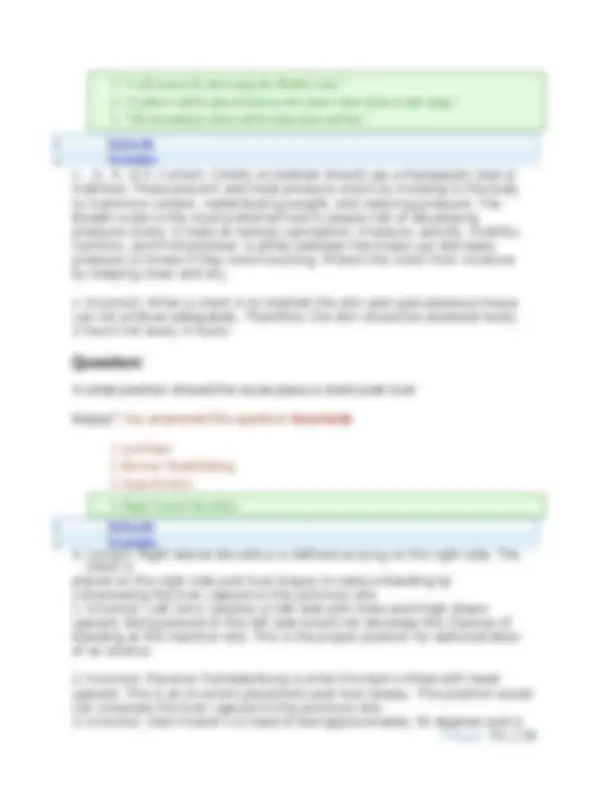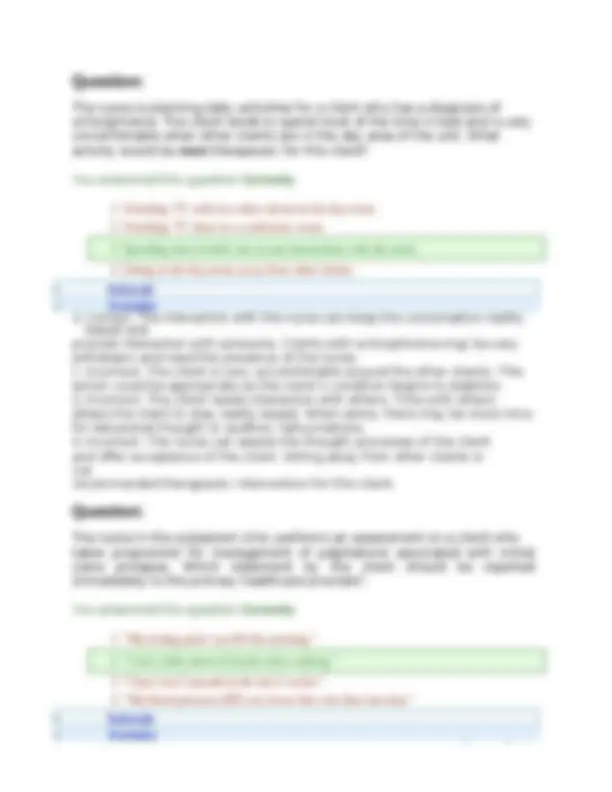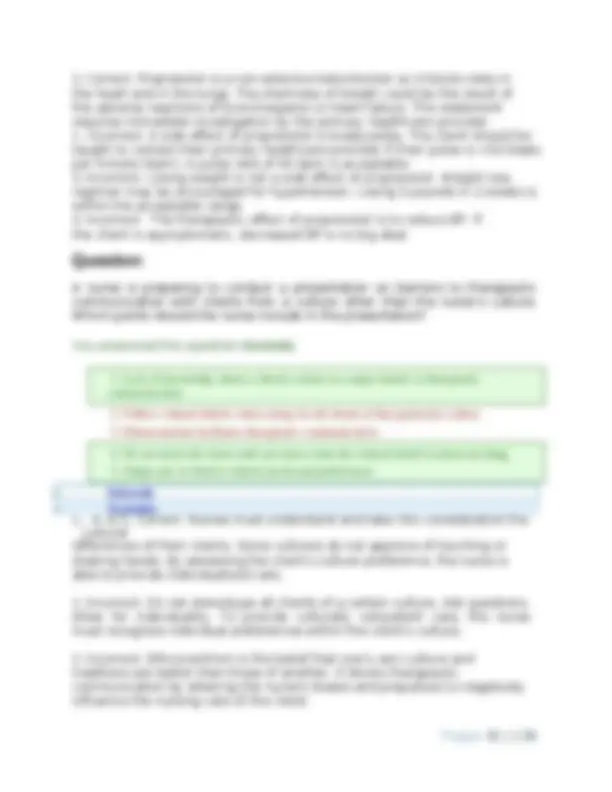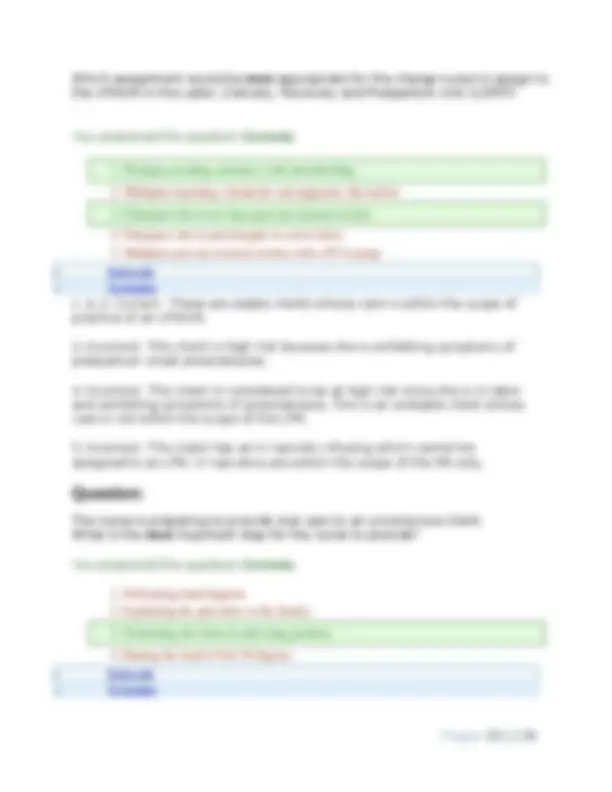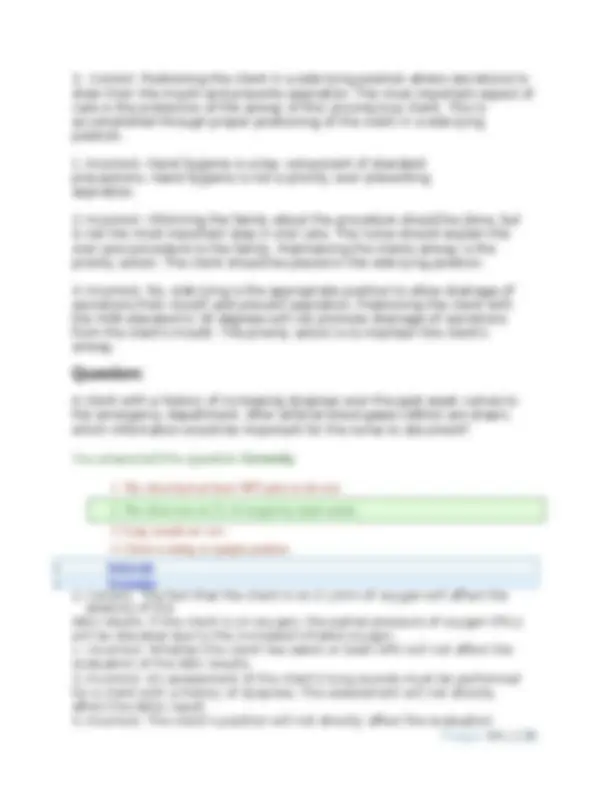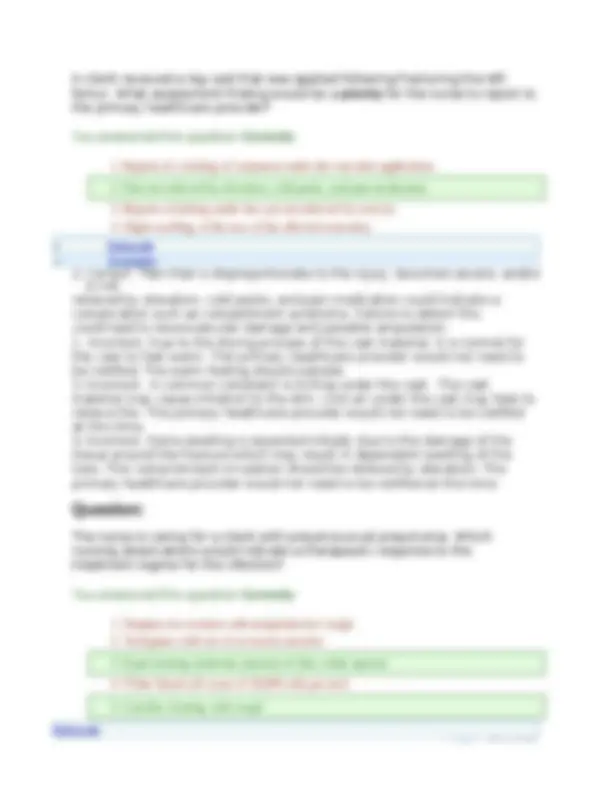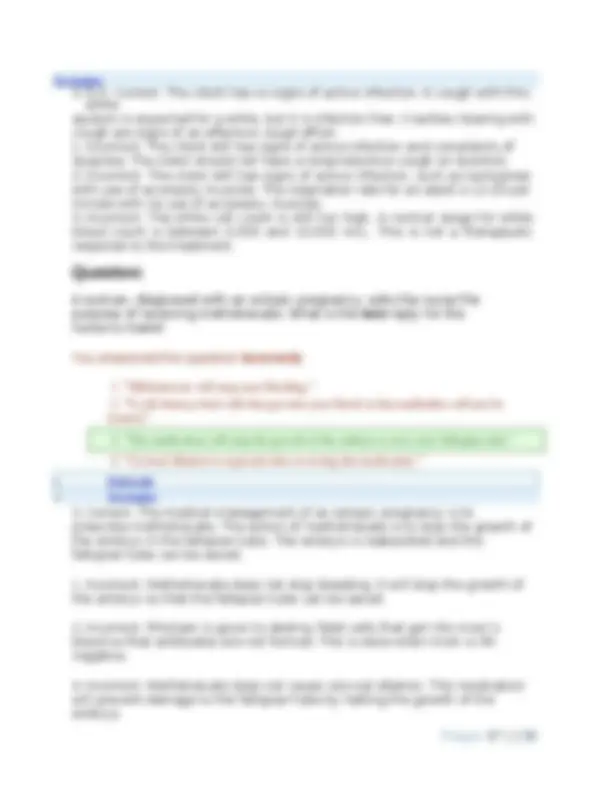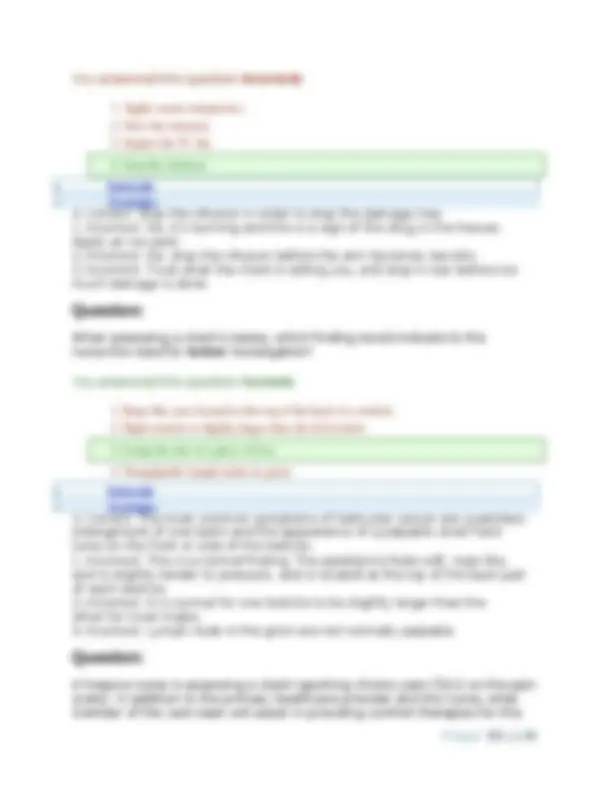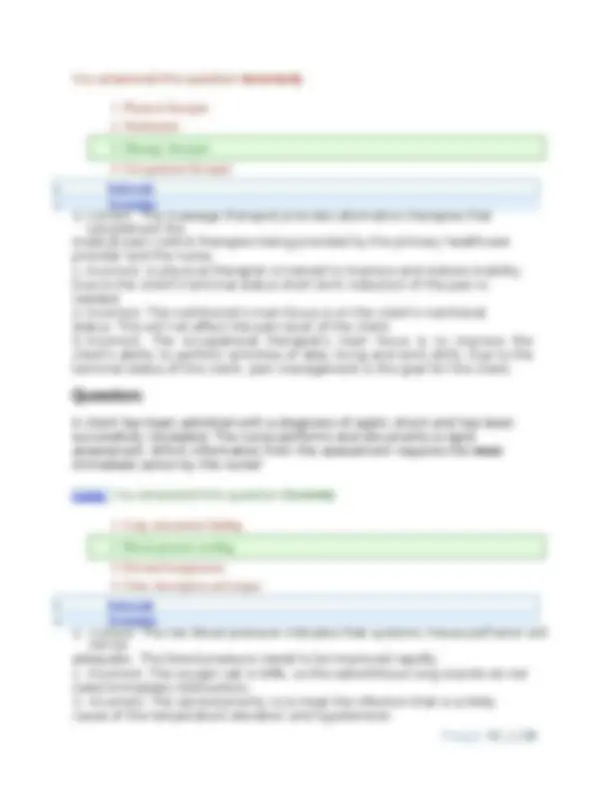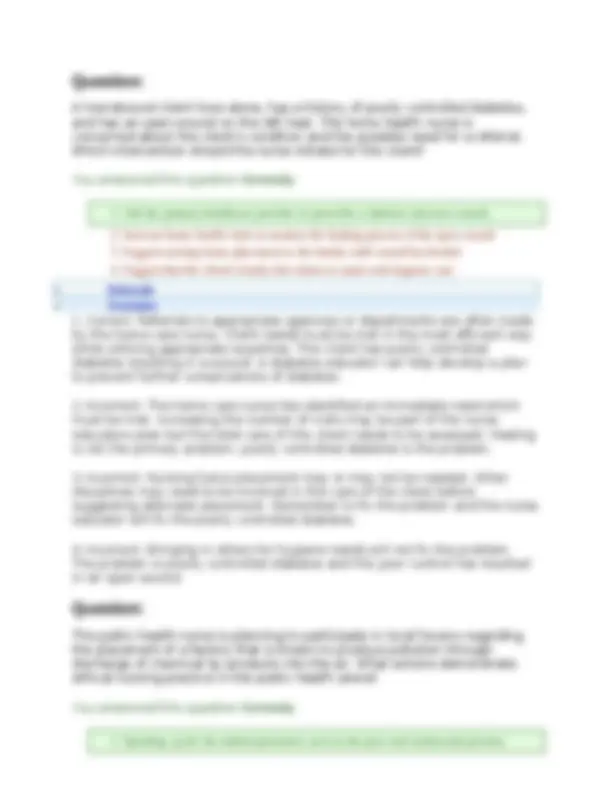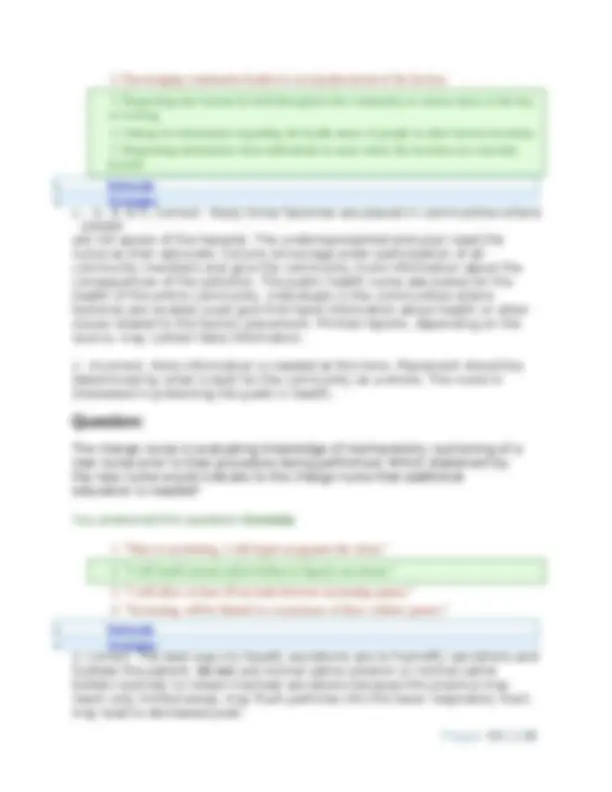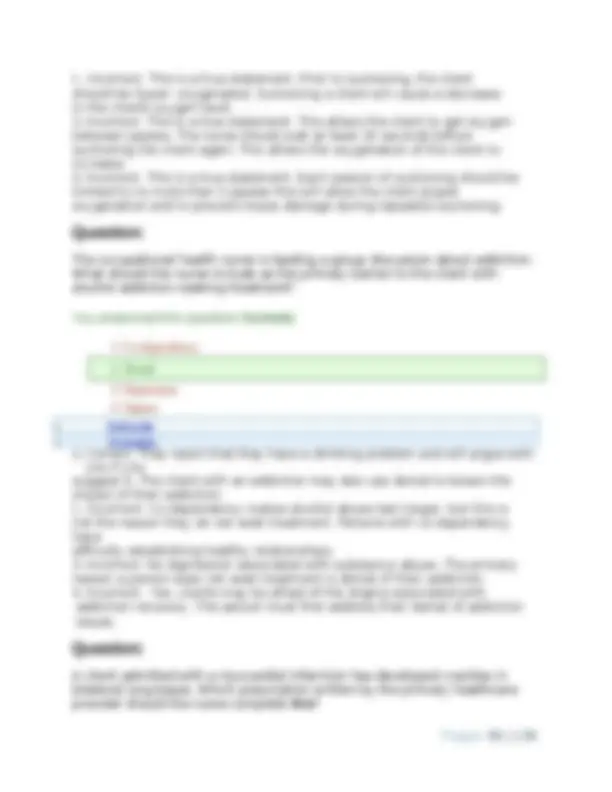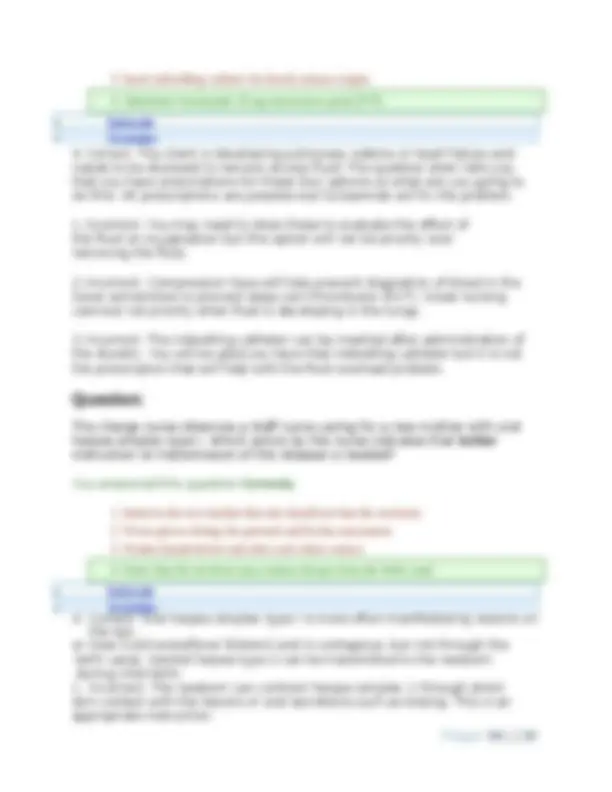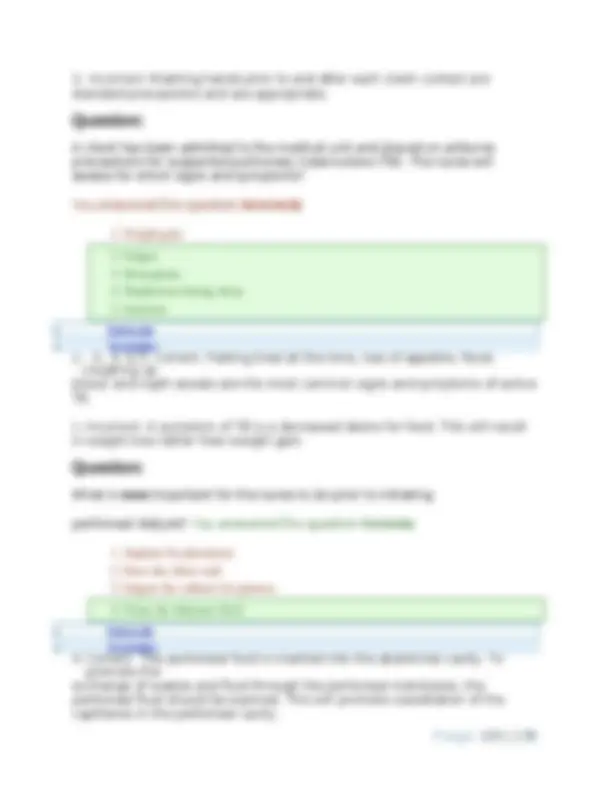Download N/A and more Exams Nursing in PDF only on Docsity!
RNSG 2331 - Exam 3-Capstone-1.Questions And Answers
Latest Update 2023
Question:
Which observations by the nurse indicate that a mother is protecting her two day old female newborn from infection? You answered this question Incorrectly
- Places the top of the diaper just above the umbilicus.
- Wraps sterile petroleum gauze around umbilical cord.
- Submerges newborn in warm water up to the chest for first bath. 1., & 2. Correct: Cleaning from front to back will decrease the risk of infection by reducing the number of microorganisms at the urethral meatus. Keeping the umbilical cord clean and dry will decrease the risk of infection and will allow it to fall off.
- Incorrect: The top of the diaper should be placed just below the umbilicus to prevent exposure to body waste and moisture. Placing the diaper above the umbilical cord will cause the diaper to rub the umbilicus, which will increase the risk of infection.
- Incorrect: This would keep the umbilical cord moist and could lead to infection. Also a sterile dressing is not warranted. The umbilical cord needs to be kept dry so it will fall off.
- Incorrect: The newborn should not be placed in water until after the umbilical cord falls off. Water submersion keeps the cord moist and at risk for infection. The umbilical cord should be kept dry so that it will fall off.
Question:
A client tells the nurse, “I am dying from cancer. I have told my primary healthcare provider that I do not want to be revived if my heart stops beating or I stop breathing.” What action should the nurse take first to assure that the client’s request is respected?
- Cleans perineum from front to back after newborn soils diaper.
- Makes certain the umbilical cord remains dry with each diaper change. -^ Strategies -^ Rationale
You answered this question Incorrectly
- Report client wishes during the end-of-shift report.
- Have the client sign an advanced directive.
- Ask the client who holds the durable power of attorney for health care decisions.
- Correct: The nurse should check the medical record for a DNR order. By law, a person who does not have a do-not-resuscitate (DNR) prescription, must be provided CPR in the event of a cardiac/respiratory arrest. This action will ensure the client’s end- of-life wishes have been communicated and will honor the client’s wishes.
- Incorrect: It is appropriate to report the client’s end-of-life wishes to other care givers, but not before ensuring a DNR order is in place.
- Incorrect: If the client has advance directives, a copy should be placed in the medical record. However, a DNR prescription must also be in place to ensure the client is not resuscitated.
- Incorrect: The client's request can be initiated by notifying the primary healthcare provider. It would be helpful for the client to have a durable power of attorney.
Question:
A client recently diagnosed with diabetes is sent home with a prescription for subcutaneous insulin. What statement made by the client indicates that teaching has been effective regarding safe needle disposal? You answered this question Correctly
- "I should wrap the needle in a paper towel and place in the trash."
- "I should use a hospital issued biohazard container for all needles."
- "I should take my needles to the nearest hospital for disposal. "
- Correct: At home, an FDA approved sharps container is not needed, however, -^ Strategies -^ Rationale
- Ensure a do-not-resuscitate prescription has been provided. -^ Strategies
- "I may use any hard plastic container with a screw-on cap."
parental consent.
- Incorrect: Consent for a minor is not needed in the event of an emergency. This is an emergency, so begin treatment for DKA.
Question:
The nurse is caring for a client in the emergency department. The primary healthcare provider prescribed 1000 mL of D 5 ½ NS. The IV is infusing at 25 gtts/min. (Drop factor is 60 gtts/mL). What is the infusion time in hours? Round your answer to the nearest whole number. You answered this question Correctly Enter the answer for the question below. Strategies Rationale Step 11000 x 60 = 25 total fluid x drop factor = infusion time
Question:
The nurse is caring for a client in an outpatient clinic. The client is being treated with warfarin for prevention of a stroke due to atrial fibrillation. The international normalized ratio (INR) was noted to be 4.6. What should the nurse do? You answered this question Correctly
- Instruct the client to continue medication as ordered.
- Inform the client to return to the clinic per routine monitoring schedule.
- Take no action as this value is within target range.
- & 3. Correct: The primary healthcare provider should be notified. The value of 4 is above the usual target range of 2-3. The client has a potential for decreased clotting and bleeding. The client should be told to watch for signs of bleeding.
- Incorrect: The medication dosage is likely to be reduced.
- Incorrect: The client should not leave the clinic until the primary healthcare provider has been notified. Further action is indicated and may include changing the usual warfarin dosage.
- Incorrect: The normal range for a INR is 2-3. When a client is prescribed warfarin, the INR should increase to a therapeutic target range. The value of 4.6 is greater than the usual target range.
Question:
x time in minutes 60,000 = 25 x 25x = 60, x = 2400 min. divide by 60 = 40 hours
- Inform the primary healthcare provider immediately. -^ Strategies -^ Rationale
- Inform the client to watch for signs of bleeding.
You answered this question Correctly
- Tell a female client who has recurrent urinary tract infections how to wipe after urinating.
- Collects a urine specimen from an indwelling catheter tubing.
- Irrigate the foley catheter of a client who has had transurethral resection of the prostate (TURP).
- , 4., & 6. Correct: These are all tasks that can be performed by the UAP. The UAP has received training for completing these tasks.
- Incorrect: The UAP cannot provide teaching; that is planned and implemented by the RN.
- Incorrect: This is out of the scope of practice for the UAP as it is requires entering a sterile system using sterile technique.
- Incorrect: The UAP does not have the knowledge and skill to irrigate catheters of any kind. This is a skilled procedure.
Question:
A client was prescribed thioridazine hcl five days ago and presents to the emergency department with a shuffling gait, tremors of the fingers, drooling, and muscle rigidity. Which adverse reaction to this medication does the nurse suspect? You answered this question Correctly
- Akinesia
- Neuroleptic malignant syndrome
- Oculogyric crisis -^ Strategies -^ Rationale -^ Strategies -^ Rationale
- Obtain blood pressure of client diagnosed with nephrotic syndrome.
- Perform perineal care of a client who has urinary incontinence.
- Pseudoparkinsonism
- Document the intake and output of a client in acute renal failure.
- Correct: Pseudoparkinsonism may appear 1 to 5 days following initiation of antipsychotic medications: occurs most often in women, the elderly, and dehydrated clients. Symptoms include tremor, shuffling gait, drooling, and rigidity.
- Incorrect: Akinesia is defined as muscle weakness. This client is not presenting with this symptom.
- Incorrect: Neuroleptic malignant syndrome is a rare, but fatal complication of neuroleptic drugs. Symptoms include hyperpyrexia up to 107 degrees, tachycardia, tachypnea, fluctuations in BP, diaphoresis, coma.
- Incorrect: Oculogyric crisis is uncontrolled rolling back of the eyes and may appear as part of dystonia (involuntary muscular movements of face, arms, legs, and neck). Oculogyric crisis is not a side effect of thioridazine.
Question:
A nurse is planning to teach a group of men about their sildenafil prescription. What information should the nurse include? You answered this question Correctly
- This medication protects against sexually transmitted diseases.
- This medication is most effective if taken with grapefruit juice.
- , 3., & 5. Correct: Alpha-adrenergic blockers action is to dilate small muscles. The action of sildenafil is also to dilate specific small muscles. The combination of these medications can cause a hypotension event. Sildenafil is usually taken only when needed, 30 minutes to 1 hour before sexual activity. Do not take sildenafil more than once per day. The most common side effects are flushing, headache, and dyspepsia.
- Incorrect: This medication does not protect against sexually transmitted diseases. Safe sex practices should be followed, such as use of latex condoms.
- Incorrect: Grapefruit and grapefruit juice may interact with sildenafil and lead to unwanted side effects. Avoid the use of grapefruit products -^ Strategies
- Notify primary healthcare provider if prescribed an alpha-adrenergic blocker.
- The most common side effects are flushing, headache, and dyspepsia.
- Sildenafil should be taken only once per day if needed.
The charge nurse has received report from the emergency department about a client diagnosed with Cushing’s disease being admitted to the unit. Which client in a semi- private room would be appropriate for the charge nurse to have this client share? You answered this question Correctly
- Client who has leukemia.
- Client diagnosed with gastroenteritis.
- Client diagnosed with bronchitis.
- Correct: The client with Cushing’s disease could go in the room with the client who has a fractured hip, as this client does not have an infection.
- Incorrect: Both of these clients are immunocompromised and should not share a room with each other.
- Incorrect: The client with gastroenteritis poses a risk of infection to the client with Cushing’s disease because this client is immunosuppressed.
- Incorrect: The client with bronchitis poses a risk of infection to the client with Cushing’s disease.
Question:
Which finding should a nurse expect when assessing a healthy 65 year old client? You answered this question Correctly
- Anomia
- BP 156/
- Apraxia
- Correct: As the lens becomes less flexible, the near point of focus gets further away. This condition, presbyopia, usually begins in the 40s. Reading glasses to magnify objects are required.
- Incorrect: Anomia (cannot name objects) is an early sign of Alzheimer’s -^ Strategies -^ Rationale
- Client who has a fractured hip.
- Presbyopia -^ Strategies -^ Rationale
disease. Anomia is not a normal assessment of a 65 year old client.
- Client is concerned over pain control postoperatively.
- Correct: The client may be pregnant, so a pregnancy test will need to be completed prior to administering anesthetic agents. As you look at these options they are all possible but only one is a priority and in this case life threatening.
- Incorrect: Adequate caregivers can be discussed with the client without contacting the primary healthcare provider. This is important but not the priority to report to the surgeon.
- Incorrect: Every person who has a surgical wound is at risk for dehiscence especially in the first two weeks after surgery. Educate the client concerning signs and symptoms and causes of dehiscence but this is not your priority here.
- Incorrect: The client’s postoperative pain control will be discussed both before and post surgery. Always discuss clients concerns prior to surgery and consult the primary healthcare provider if you are unable to satisfy the client.
Question:
A nurse has just inserted an indwelling urinary catheter in a client scheduled for surgery. What should the nurse document? You answered this question Correctly
- Infusing rate of IV fluid 1., 2., 3., 4., & 5. Correct: Perineal skin assessment should be assessed prior to insertion of the indwelling catheter. The following documentation is appropriate after inserting an indwelling catheter: Client teaching, color of the urine, date and time of the insertion and the type of catheter inserted.
- Incorrect: Documenting the IV rate is not relevant to inserting the catheter. The infusion rate may need to be documented, but the question is asking about the documentation of the insertion of the indwelling catheter.
- Strategies -^ Rationale -^ Strategies -^ Rationale
- Perineal skin assessment
- Client teaching
- Color of urine
- Date and time of insertion
- Type catheter inserted
A client arrives at the emergency department after sustaining partial and full- thickness burns over the anterior neck, chest, and right arm. Which interventions will the nurse initiate? You answered this question Correctly
- Debride wounds 1., 2., 3., & 4. Correct: Burns over the anterior neck and chest mean that the client is likely to have inhalation burns, putting him/her at high risk for impaired gas exchange. The inhalation will cause edema of the airway. It goes back to Maslow’s Hierarchy of Needs. Administer oxygen and start two IVs so that fluid resuscitation can begin. Metal continues to burn and swelling will occur, so remove the necklace or any jewelry. Elevate the arm to decrease swelling.
- Incorrect: Debridement of the wound occurs in the acute/intermediate phase. This phase starts 48-72 hours after the burn accident has happened.
Question:
A client with dementia has been admitted to the medical floor. The family informs the nurse that the client tends to wander at night. When planning client safety goals, which action by the nurse would take priority? You answered this question Incorrectly
- Place client with a roommate who is able to notify staff when client wanders.
- Discuss safety goals with family, encouraging them to spend time with client.
- Reorient the client every shift regarding floor policies and safety procedures.
- Correct: The family specifically informed the nurse that the client wanders at night. When preparing care plan safety goals, the nurse
- Strategies -^ Rationale -^ Strategies -^ Rationale
- Administer oxygen
- Start two intravenous lines
- Remove necklace
- Elevate right arm
- Designate an unlicensed assistive personnel (UAP) to sit with the client through the night.
understands the priority is to ensure client safety and have staff personnel to stay with the client during those hours of wandering. This action does not require a licensed nurse; therefore, a unlicensed assistive personnel UAP is the most appropriate staff to sit with the client.
What should the nurse include in the post-op care of a client following the removal of the posterior pituitary gland?
You answered this question Correctly
- Restrict fluids to no more than 1500 ml/day.
- , 3., 4., 5., & 6. Correct: Removal of the pituitary gland can lead to diabetes insipidus (DI) as a result of the reduced production of antidiuretic hormone (ADH). The nurse should monitor I & O closely and watch for an increase in output which would indicate diuresis as part of DI. Daily weights are an important part of monitoring the client’s fluid status. Monitoring the urine specific gravity is another good way of assessing the fluid status because, as the urinary output increases, the client’s urine is becoming more dilute, which would result in a lower urine specific gravity. If the client’s serum volume is decreasing from the excessive diuresis, the client can go into shock. The nurse should monitor for early signs of changes in the level of consciousness. To avoid disrupting the surgical site, the client should not blow the nose forcefully for at least one week post-op.
- Incorrect: If the client is lacking ADH, the client may begin losing large amounts of fluid volume. Therefore, the fluid intake would need to be increased (not decreased) to avoid dehydration and shock.
Question:
What should a nurse teach a client who has been diagnosed with hepatitis A? You answered this question Incorrectly
- Hepatitis A is spread through blood and body fluid.
- Chronic liver disease is a common complication of hepatitis A.
- Treatment includes alpha-interferon and ribavirin.
- Correct: Symptoms of hepatitis A include fever, malaise, loss of
- Strategies -^ Rationale -^ Strategies
- Rationale
- Monitor intake and output.
- Symptoms of hepatitis A include malaise, dark colored urine, and jaundice.
- Weigh daily.
- Monitor urine specific gravity.
- Assess the level of consciousness (LOC).
- Instruct client to avoid blowing the nose forcefully.


